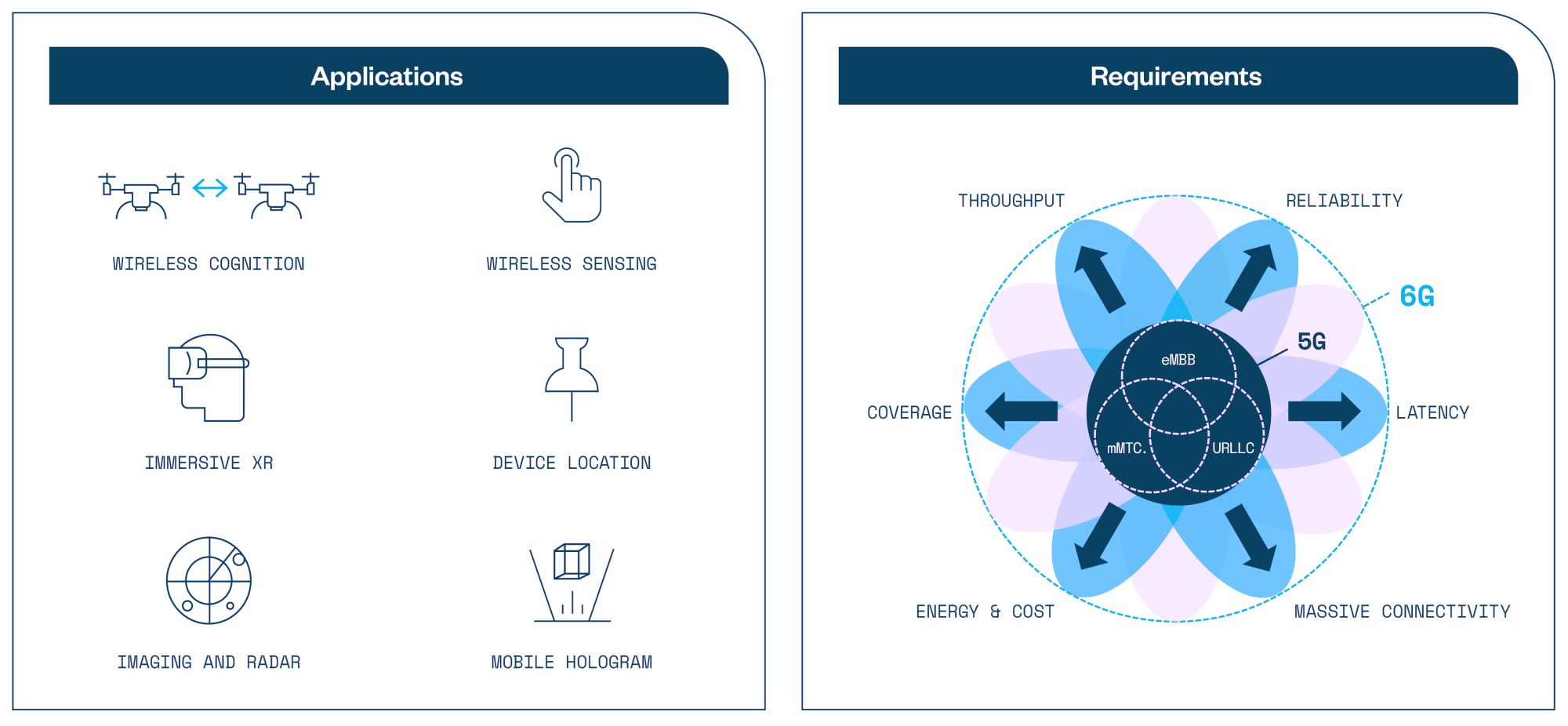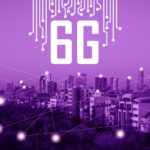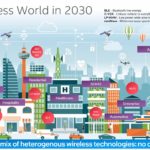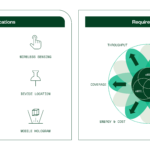By Charles Schroeder, business and technology fellow, National Instruments
Although the first 6G consumer devices may be years away, work on 6G is underway. Academic and industry researchers are already experimenting and developing an understanding of key technologies as crucial inputs for standardization work. The industry must balance technical, business, and social considerations when developing 6G.
Consumers and businesses are only just becoming aware of the potential of 5G, and while adoption of the new technology is expected to happen more quickly than it did for 4G, we are still at the beginning of 5G commercialization. 5G networks being deployed today have just a subset of the capabilities envisioned (and in some cases promised) for 5G and will continue to be updated over time. Even so, scientists and engineers are already working on defining, researching and testing the fundamental candidate technologies for 6G. To better understand the future of 5G and 6G, it’s important to understand how we got here.
Early generations of cellular communications (1G and 2G) focused on voice. Taking the functionality of the telephone outside the home or office and being reachable anywhere was the main goal. 3G and 4G focused on connecting to the internet, streaming video, social media, and other applications. 5G initiated a vision for connecting all kinds of devices across different industries and applications including smart homes, connected cars, and industrial IoT. 6G will follow this trend.
Figure 1 shows a timeline to define, develop, and deploy a new wireless standard, which typically takes about ten years. Historically, we’ve seen the odd Gs (1G and 3G) introduce revolutionary ideas and the even Gs (2G and 4G) improving or completing the implementation to achieve that vision. For 5G, the Third Generation Partnership Project (3GPP) began working on standardization in 2015, but critical research by leading groups such as NYU Wireless and METIS started several years earlier.
Figure 1. From research and standardization through to release and rollout, the cellular technology evolution cycle is roughly ten years.
3GPP Release 15 marked the completion of phase 1 of the 5G New Radio (NR) standard in 2018 and was quickly followed with field trials and the first commercial deployments. Looking ahead to 6G, the pattern appears to be holding, with early 6G research taking place in anticipation of a 2025 start date for standardization and 2030 deployment date. Reflecting on the ambitious goals for 5G, it also appears that 6G will continue to improve on 5G with the promise of connecting every person and machine (Figure 2).
What can 6G bring to the table?
The Network 2030 Focus Group of the International Telecommunications Union (ITU) started work on a vision for 6G, the same way it set targets for 5G in the IMT-2020 standard. Throughput, reliability, coverage, latency, energy, cost, and massive connectivity were grouped into three 5G usage scenarios — enhanced mobile broadband (eMBB), massive machine type communications (mMTC), and ultra-reliable low latency communications (URLLC) — supporting a wide range of applications across many industries (Figure 3).
Building on these vectors, 6G is expected to enable new use cases and business models while also driving advancements in existing applications. Unlike prior G’s where most wireless connections were initiated by people making calls or getting information, 5G and 6G will see machines increasingly initiating these connections.
Technologies worth exploring
People want more speed and reliability from networks. When machines begin using these networks for mission-critical or safety-critical tasks, the requirements for speed, latency, reliability, and density increase. These machines will also need to sense and understand their environment and intelligently manage the network to accomplish their goals. Four promising technologies stand out in terms of market potential and feasibility as we consider 6G’s possibilities:
- Integrated sensing and communications
- Sub-Terahertz bands
- Multiple-input and multiple-output (MIMO)
- Artificial Intelligence (AI) / Machine Learning (ML)
Integrated sensing and communications
To enable 5G and 6G, our devices will need more understanding of the natural world enabled by advanced sensing. Integrated communications and sensing explore how to use the radio signals that cellular devices emit for radar. Autonomous vehicles, for example, have advanced sensing systems that fuse data from a variety of cameras, lidar, and radar sensors using ML algorithms. In this use case, integrated sensing and communication will let vehicles use the RF spectrum more efficiently by sharing spectrum for radar and communications, thus accomplishing two tasks.
Sensing researchers are looking to communications technologies to improve interference mitigation. In contrast, communications researchers see opportunities for more data bandwidth in the vast swaths of radar-allocated spectrum. Besides the regulatory and technical factors involved in combining these two technologies, engineers with radar and communications backgrounds will need to cooperate on a common set of goals. Progress in this area will depend on it.
Sub-terahertz bands
Due to the constant demand for more data bandwidth, researchers such as those at Northeastern University are pushing beyond the mmWave bands introduced in 5G and exploring underutilized spectrum in the sub-THz frequency bands. Frequency bands between 90 GHz and 300 GHz provide many times the amount of bandwidth that those currently used for cellular communications.
Path loss at higher frequencies is a significant barrier to moving to sub-THz bands. It may be mitigated by matching a frequency band’s attenuation properties with appropriate applications. Using high-attenuation bands for high-security applications, for example, limits how far the signal travels. Furthermore, the inverse relationship between frequency and antenna size provides one method for overcoming pathloss. As frequency rises, antenna geometry and spacing shrink, allowing for more elements and thus more gain in the same footprint. Even if it may seem premature to expand to sub-THz bands given the delay in 5G mmWave deployments to date, academic and industry researchers are exploring it to increase network capacity.
MIMO
Building on popular multi-antenna techniques, MIMO promises potential benefits across many use cases and frequency bands. While beamforming is key to overcoming sub-THz pathloss challenges, multi-user MIMO improves spectral efficiency for the heavily used sub-6 GHz bands. In bands where antenna size becomes excessively large, distributed MIMO is especially interesting. This technique disaggregates the large antenna arrays into multiple, geographically separated radio heads that are significantly smaller. The expansion of MIMO aims to increase cell capacity and provide improved location services.
AI and ML
AI/ML is the fourth technology that plays a significant role in 6G. With increasing complexity, squeezing every bit of bandwidth from the available spectrum becomes a key focus. Traditional signal processing approaches it is increasingly difficult to optimize the communication system. One way of dealing with this complexity is to use machine learning. AI/ML-driven design or adaptation to optimize link performance dynamically can provide improvements in areas like beam management, automatic spectrum allocation, and RF non-ideality cancellation. The use of AI/ML at the application layer allows the optimization of quality of service (QoS) for factors such as latency or energy efficiency, which take into consideration application-specific requirements, together with the environment.
This introduction of ML into networks presents several new challenges including the need for large, open data sets for wireless communications research and training of AI/ML algorithms. Additionally, new testing methodologies must be developed to validate the performance and security of the ML algorithms under the infinite number of uses cases they will experience in the real-world.
What’s more important than technology?
Researching, developing, and deploying a new cellular network is expensive. To warrant these investments, technology companies across the globe are exploring new, compelling business cases in connecting people and in connecting devices and machines. As the 5G rollout continues and new products and services build on top of it, moving us closer to the vision of connected everything, the role that 6G can fill may become clear.
Another topic of discussion for 6G is sustainability and social responsibility. As the performance of networks has grown over time, so has energy consumption. Given the goals for increased network performance and ubiquity, 6G will need to tackle the challenge of achieving this higher performance while improving energy efficiency, and thus reducing operating costs and improving the carbon footprint. It’s total energy consumption, not just energy per bit.
We have relied on connectivity and virtual experiences throughout the recent global events. Many of us have a new appreciation for a reliable, high-speed network. Many families have had to adapt to remote work or school, and in underserved rural areas the severity of the digital divide has been brought to the forefront. In addition to technology buzzwords like immersive extended reality and key performance indicators such as 1 Tb/s data rates, 6G discussions now include social and sustainability goals such as “connectivity for all.” As we work to develop 5G by extending it beyond enhanced mobile broadband, and as the definition of 6G coalesces, we need to answer these business and social questions as well as the technical ones.
 Charles Schroeder is a business and technology fellow at NI. He consults with executive leaders and department heads, including those from marketing, sales, and R&D, to drive the company’s strategic direction, development, and future growth. Ge currently leads NI’s efforts to find ground-breaking solutions to the test challenges introduced by the adoption of 5G and 6G cellular technologies.
Charles Schroeder is a business and technology fellow at NI. He consults with executive leaders and department heads, including those from marketing, sales, and R&D, to drive the company’s strategic direction, development, and future growth. Ge currently leads NI’s efforts to find ground-breaking solutions to the test challenges introduced by the adoption of 5G and 6G cellular technologies.
Schroeder has held various positions at NI, including VP of product marketing for RF and wireless communications and leadership roles across the RF, modular instruments, DAQ, and IMAQ Vision product lines. He holds bachelor’s and master’s degrees in electrical engineering from Texas A&M University.








